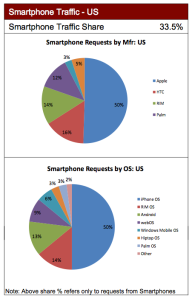So you’ve got an iPhone App, now what?
Congratulations! You’ve entered the world of mobile media and (hopefully) rolled out an amazing new way for consumers to interact with your company. You’ve got an app on one of the world’s most popular smartphones, and certainly one that’s driven vast mobile media innovation in the past two years. However, at best, you’re reaching slightly less than 50% of the smartphone traffic market.
Sure, BlackBerrys abound, and they’re even given away seemingly every other week during different promotional sales. However, it’s not the numbers of sales that are important. You’ve got to look at mobile traffic; that indicator that phone users are paying for an always-connected smartphone with internet browsing capabilities. Luckily, AdMob, the iPhone’s premiere service for in-app advertising, offers helpful metrics for measuring and determining just how people use their smartphones.
 Not surprisingly, the iPhone dominates the market with half of all mobile internet traffic. But you knew that—that’s why you developed an app in the first place!
Not surprisingly, the iPhone dominates the market with half of all mobile internet traffic. But you knew that—that’s why you developed an app in the first place!
BlackBerry vs. Android vs. WebOS
If you’re not of a budget that will allow you to pay a developer to create applications across each of the major operating systems at the same time, you’ll have to choose a priority. My suggestion: go Android. Over the past three months, Admob has shown a steady increase in traffic share for Android-based phones in the US. Currently, Google has announced that it anticipates another dozen (in addition to the current three) phones running on Android in coming months.
Next to BlackBerry, that’s huge. Right now, there are only two BlackBerry devices that can be considered fair competition to Android and iPhone: the Curve and the Storm. Both debuted more than 6 months ago, and neither has revolutionized the way we use mobile internet. There are also no announcements about new phones—who’s to know when the next iterations will come.
The Palm Pre debuted to major critical acclaim, but sales numbers never really left the ground. While the phone ranks in the top five handsets for traffic, it’s still the only device running Palm’s WebOS. While surveys of consumers have shown that people hold the Pre in higher regard than existing Android and BlackBerry devices, it still probably won’t pay off to invest in development of a WebOS app—at this point at least.
UPDATE: Flash on mobile devices
Then again, recent announcements may change the way all mobile development unfolds across platforms. Adobe announces Flash will be coming to smartphones, including immediate rollouts to Windows Media, WebOS, public beta early next year for Android, and an undisclosed debut date for BlackBerry.
Whether or not this changes your strategy depends on what you’re trying to deliver. For a client of mine who delivers video content, it makes sense for them to continue to develop apps that are specifically designed for mobile devices. They run better and faster on a mobile device than a flash site ever will. But, like all things, you’ll still pay a price for a customized experience.




Leave a comment